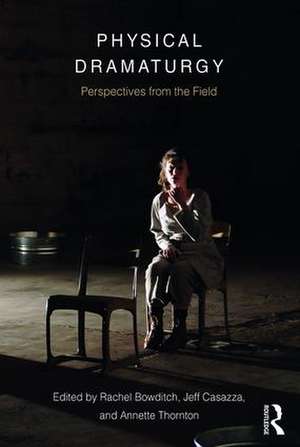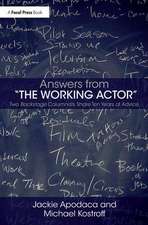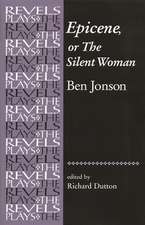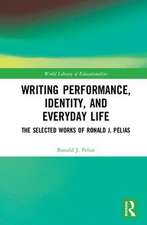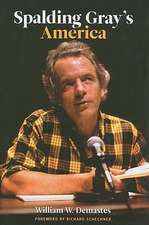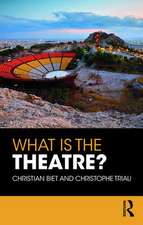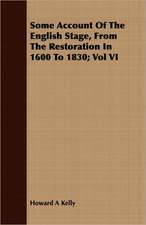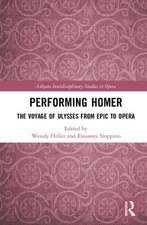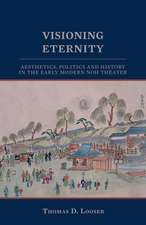Physical Dramaturgy: Perspectives from the Field
Editat de Rachel Bowditch, Jeff Casazza, Annette Thorntonen Limba Engleză Paperback – 20 iun 2018
Physical Dramaturgy: Perspectives from the Field explores the ways in which this unique role can benefit the production team during the design and rehearsal phases of both traditional and devised productions. Individual chapters look at new ways of approaching a wealth of physical worlds, from the works of Shakespeare and other period playwrights to the processes of Jerzy Grotowski, Lloyd Williamson, Richard Schechner, and Michael Chekhov, and devising original works in a variety of contexts from Pig Iron, Dell’Arte International, Bill Bowers and mime, Tectonic Theater Project, and Liz Lerman’s Dance Exchange.
This anthology gives dramaturgs, actors, and directors new ways of looking at existing methods and provides examples of how to translate, combine, and adapt them into new explorations for training, rehearsal, or research.
| Toate formatele și edițiile | Preț | Express |
|---|---|---|
| Paperback (1) | 288.46 lei 3-5 săpt. | +21.41 lei 6-10 zile |
| Taylor & Francis – 20 iun 2018 | 288.46 lei 3-5 săpt. | +21.41 lei 6-10 zile |
| Hardback (1) | 764.20 lei 6-8 săpt. | |
| Taylor & Francis – 13 iun 2018 | 764.20 lei 6-8 săpt. |
Preț: 288.46 lei
Nou
Puncte Express: 433
Preț estimativ în valută:
55.20€ • 60.14$ • 46.51£
55.20€ • 60.14$ • 46.51£
Carte disponibilă
Livrare economică 02-16 aprilie
Livrare express 18-22 martie pentru 31.40 lei
Preluare comenzi: 021 569.72.76
Specificații
ISBN-13: 9781138682887
ISBN-10: 1138682888
Pagini: 256
Ilustrații: 1 Tables, black and white; 20 Halftones, black and white
Dimensiuni: 156 x 234 x 17 mm
Greutate: 0.42 kg
Ediția:1
Editura: Taylor & Francis
Colecția Routledge
Locul publicării:Oxford, United Kingdom
ISBN-10: 1138682888
Pagini: 256
Ilustrații: 1 Tables, black and white; 20 Halftones, black and white
Dimensiuni: 156 x 234 x 17 mm
Greutate: 0.42 kg
Ediția:1
Editura: Taylor & Francis
Colecția Routledge
Locul publicării:Oxford, United Kingdom
Public țintă
Postgraduate and UndergraduateCuprins
List of illustrations; List of contributors; Preface; Acknowledgments; Introduction; PART I Historical styles and case studies from the Greeks to contemporary theatre; Chapter 1 Embodying Greek period style: Physical dramaturgy in staging Euripides’ Medea; Chapter 2 Festina Lente and Sprezzatura in action: Unlikely sources of physical dramaturgy in Shakespeare’s Love’s Labour’s Lost and As You Like It; Chapter 3 Shakespeare’s text in the body of the character in The Winter’s Tale; Chapter 4 Period style: The physical dramaturgy of Loyd Williamson’s Salon; Chapter 5 Understanding the world of the play through period movement; PART II Inner landscapes: Dramaturgy from within; Chapter 6 Dramaturgy as litany; Chapter 7 A dramaturgy of embodiment: The study and practice of experiential anatomy; Chapter 8 The augmented body; Chapter 9 Mining the imagination: A physical approach to the creation of story with Action Theater; PART III Acts of translation: Physical dramaturgy in the rehearsal room; Chapter 10 Devising Brechtian moments: The transformation of traditional dramaturgy into physical dramaturgy; Chapter 11 "Lit from within": Non-traditional casting in Chekhovian realism through physical dramaturgy; Chapter 12 The alchemy of re-composing history in Iphigenia and Other Daughters; 13 Quadruple threat musical theatre: Adding the physical dramaturg; Chapter 14 Kinetic analysis and gesture mapping in The Government Inspector and Anton’s Shorts; PART IV Physical dramaturgy in the devising process; 15 The search for synecdoche: Insight into Pig Iron Theatre Company’s physical dramaturgy. Quinn Bauriedel interview, July 29, 2016; Chapter 16 Devising ‘madness’: Physical dramaturgy in The Ophelia Project and Asylum; Chapter 17 The phenomenon of silence. Bill Bowers interview, September 9, 2017; Chapter 18 Butoh, landscape theatre, and the physical dramaturgy of Gale GAtes et al.; Chapter 19 Moment Work: Exploring the full potential of the stage. Moisés Kaufman interview, July 20, 2017; Chapter 20 Physical dramaturgy: Reflections for the actor, director, designer, and deviser; Index
Notă biografică
Rachel Bowditch (PhD in Performance Studies, New York University) is a theatre director, an associate professor, and Head of the MFA in Performance at the Herberger Institute for Design and the Arts at Arizona State University, USA. Bowditch was President of the Association of Theatre Movement Educators from 2016–2018.
Jeff Casazza (MFA in Directing, Florida State University) is a designated Linklater voice teacher, director/deviser, playwright, and actor. He is an associate professor and Head of Acting, Movement, and Voice at Purdue University Fort Wayne, USA.
Annette Thornton (PhD in Theatre, University of Colorado Boulder) is an associate professor at Central Michigan University, USA, where she teaches courses in music theatre, performance, and history. Thornton was President of the Association of Theatre Movement Educators from 2012–2016.
Jeff Casazza (MFA in Directing, Florida State University) is a designated Linklater voice teacher, director/deviser, playwright, and actor. He is an associate professor and Head of Acting, Movement, and Voice at Purdue University Fort Wayne, USA.
Annette Thornton (PhD in Theatre, University of Colorado Boulder) is an associate professor at Central Michigan University, USA, where she teaches courses in music theatre, performance, and history. Thornton was President of the Association of Theatre Movement Educators from 2012–2016.
Descriere
What is physical dramaturgy?
While the traditional dramaturg shares research intellectually, the physical dramaturg does so viscerally and somatically. By combining elements of text, history, dramatic structure, and the author’s intent with movement analysis and physical theatre pedagogies, the physical dramaturg gives actors the opportunity to manifest their work in a connected and intuitive manner and creates a field that is as varied and rich as the theatre itself
While the traditional dramaturg shares research intellectually, the physical dramaturg does so viscerally and somatically. By combining elements of text, history, dramatic structure, and the author’s intent with movement analysis and physical theatre pedagogies, the physical dramaturg gives actors the opportunity to manifest their work in a connected and intuitive manner and creates a field that is as varied and rich as the theatre itself
